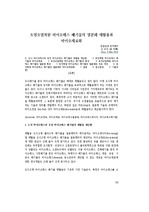

-
미리보기
목차
1. 도시 바이오매스와 토양 바이오매스 폐기물의 재활용 재순환
2. 토양복원 바이오매스 폐 기물과 바이오재료
3. 토양오염복원 바이오매스 폐기물의 특성
4. 토양오염복원 바이오 매스 폐기물의 열분해 특성
5. 토양복원 바이오매스 폐기물의 열분해와 차르 생성
6. 토양복원 바이오매스 폐기물의 열분해와 바이오재료화
7. 결론
8. 참고문헌
9. 기술보문본문내용
[요론]
도시폐기물 중의 바이오매스 폐기물은 제대로 재활용되고 있지 않다. 이제 도시형 바이 오매스 폐기물과 농어촌 바이오매스 폐기물을 효과적으로 재활용해야 하는 시대로 접어 들고 있다. 도시나 농어촌 가정의 가구와 사무실과 사업장의 기자재로부터 폐기되는 바 이오매스 폐기물과 건축자재로부터 버려지는 바이오매스 폐기물은 페인트와 니스와 접 착제 등으로 오염되어 있어, 특정하게 소각 처분하고 있다. 이러한 바이오매스 폐기물 을 재활용하려면 그 표층에 함침된 유기성・무기성 오염물질을 효율적으로 분리 제거 하는 기술과 장치를 개발해야 하고, 목탄과 같은 차르(char)도 열분해 기술로 조제하여, 바이오연료 (bio-fuel) 내지 바이오재료(bio-material)로 재활용하고 재순환시켜야 한다.
[keywords: 바이오연료, 바이오재료, 바이오매스열분해, 바이오매스에너지, 바이오매스폐기물]
1. 도시 바이오매스와 토양 바이오매스 폐기물의 재활용 재순환
재활용 도시고형 플라스틱 폐기물을 열분해하여 재이용하는 바이오에너지(bio-energy) 및 재활용 도시고형 바이오매스 폐기물을 열분해하여 생산하는 바이오재료(bio-material) 에 대한 관심이 근래 들어 크게 증가하고 있다. 또한 통상적인 곡물 생산이나 사료 생 산에는 부적합한 도시환경・산업지구 오염토양이나 물리화학적으로 퇴화된 각종 토양에 서 산출되는 바이오매스, 오염농지에서 산출되는 각종 바이오매스, 건축폐기물 중의 바 이오매스, 가정폐기물 중의 바이오매스, 목재가구 폐기물의 바이오매스, 정원・공원・가 로수 폐기물의 바이오매스(biomass) 등으로부터 생산할 수 있는 새로운 바이오재료에 대한 연구개발도 근래 들어 크게 증가하고 있다.
도시고형 바이오매스 폐기물 재활용의 기초적 기반 기술로서, 특정의 바이오매스를 오염토양에 재배하여 각종의 오염물질을 정화하고 제거하여, 오염토양을 복원시키는 식생 복원(phyto-remediation)으로 농작물과 음식물의 안전성을 확보하고 ......<중 략>참고자료
· Paola Giudicianni, et al., Pyrolysis for exploitation of biomasses selected for soil phytoremediation: Characterization of gaseous and solid products, Waste Manage., 61, 2017, pp.288~299.
· Barbosa, B., et al., Phytoremediation of heavy metal-contaminated soils using the perennial energy crops Miscanthus spp. and Arundo donax L., Bioenergy Res., 8. 2015, pp.1500~1511.
· Kambo, H.S., Dutta, A., A comparative review of biochar and hydrochar in terms of production, physico-chemical properties and applications, Renew. Sustain. Energy Rev., 45, 2015, pp.359~378.
· Veksha, A., et al., Pyrolysis of wood to biochar: increasing yield while maintaining microporosity, Bioresour. Technol., 153, 2014, pp.173~179.
· Nelissen, V., et al., Short-term effect of feedstock and pyrolysis temperature on biochar characteristics, soil and crop response in temperate soils, Agronomy, 4, 2014, pp.52~73.
· Abdullah, H., Mediaswanti, K.A., Wu, H., Biochar as a fuel: Two significant differences in fuel quality and ash properties of biochars from various biomass components of mallee trees. Energy Fuels 24, 2010, pp.1972~1979.
· Minkova, V., et al., Effect of water vapour and biomass nature on the yield and quality of the pyrolysis products from biomass, Fuel Process. Technol., 70, 2010, pp.53~61.
· Nsanganwimana, F., et al., A candidate for phytomanaging water and soils contaminated by trace elements and producing plant-based feedstock - A review, Int. J. Phytoremediat., 16, 2014, pp.982~1017.
· Liu, W.J., et al., Selectively improving the bio-oil quality by catalytic fast pyrolysis of heavy-metal polluted biomass: take copper (Cu) as an example, Environ. Sci. Technol., 46, 2012, pp.7849~7856.
· Civitarese, V., et al., Effect of short rotation coppice plantation on the performance and chips quality of a self-propelled harvester, Biosyst. Eng., 129, 2015, pp.370~377.
· Fagnano, M., et al., Agronomic and environmental impacts of giant reed (Arundo donax L.): results from a longterm field experiment in hilly areas subject to soil erosion, Bioenergy Res., 8, 2015, pp.415~422.
· Channiwala, S.A., Parikh, P.P., A unified correlation for estimating HHV of solid, liquid and gaseous fuels, Fuel, 81, 2012, pp.1051~1063.
· Ragucci, R., Giudicianni, P., Cavaliere, A., Cellulose slow pyrolysis products in a pressurized steam flow reactor, Fuel, 107, 2013, pp.122~130.
· Martins, A.F., et al., Low temperature conversion of rice husks, eucalyptus sawdust and peach stones for the production of carbon-like adsorbent, Bioresour. Technol., 98, 2007, pp.1095~1100.
· Sabia, P., et al., H2O and CO2 dilution in MILD combustion of simple hydrocarbons, Flow Turbul. Combust., 96, 2016, pp.433~448.
· Giudicianni, P., et al., Hemicellulose, cellulose and lignin interactions on Arundo donax steam assisted pyrolysis, J. Anal. Appl. Pyrol., 110, 2014, pp.138~146.
· Luo, L., et al., Properties of biomass-derived biochars: combined effects of perating conditions and biomass types, Bioresour. Technol., 192, 2015, pp.83~89.
· Gray, M., et al., Water uptake in biochars: the roles of porosity and hydro -phobicity, Biomass Bioenergy, 61, 2014, pp.196~205.
· Spokas, K.A., Review of the stability of biochar in soils: predictability of O: C molar ratios, Carbon Manage., 1, 2010, pp.289~303.
· Srinivasan, P., et al., A feasibility study of agricultural and sewage biomass as biochar, bioenergy and biocomposite feedstock: production, characterisation and potential applications, Sci. Total Environ., 512, 2015, pp.495~505.태그
-
자료후기
Ai 리뷰지식판매자의 자료는 항상 최신 정보를 반영하고 있어 믿을 수 있습니다. 특히, 각 주제에 대한 깊이 있는 분석과 명확한 설명 덕분에 복잡한 개념도 쉽게 이해할 수 있었습니다. 여러분에게도 강력히 추천합니다! -
자주묻는질문의 답변을 확인해 주세요

꼭 알아주세요
-
자료의 정보 및 내용의 진실성에 대하여 해피캠퍼스는 보증하지 않으며, 해당 정보 및 게시물 저작권과 기타 법적 책임은 자료 등록자에게 있습니다.
자료 및 게시물 내용의 불법적 이용, 무단 전재∙배포는 금지되어 있습니다.
저작권침해, 명예훼손 등 분쟁 요소 발견 시 고객센터의 저작권침해 신고센터를 이용해 주시기 바랍니다. -
해피캠퍼스는 구매자와 판매자 모두가 만족하는 서비스가 되도록 노력하고 있으며, 아래의 4가지 자료환불 조건을 꼭 확인해주시기 바랍니다.
파일오류 중복자료 저작권 없음 설명과 실제 내용 불일치 파일의 다운로드가 제대로 되지 않거나 파일형식에 맞는 프로그램으로 정상 작동하지 않는 경우 다른 자료와 70% 이상 내용이 일치하는 경우 (중복임을 확인할 수 있는 근거 필요함) 인터넷의 다른 사이트, 연구기관, 학교, 서적 등의 자료를 도용한 경우 자료의 설명과 실제 자료의 내용이 일치하지 않는 경우
문서 초안을 생성해주는 EasyAI

